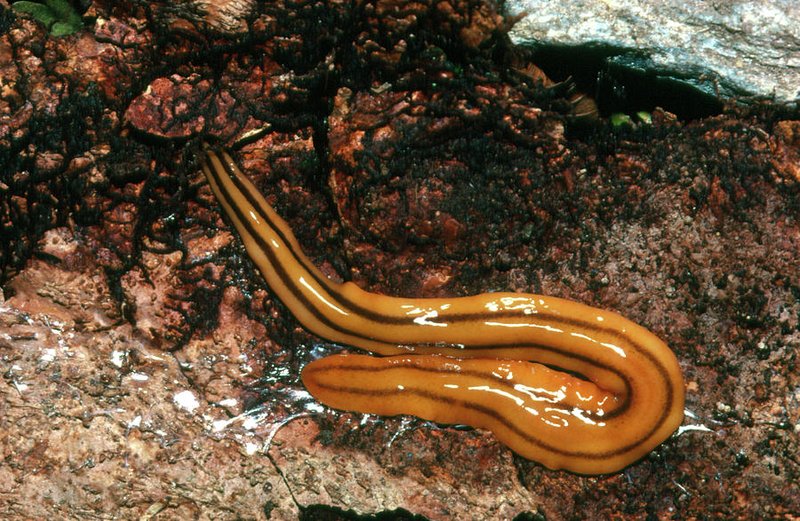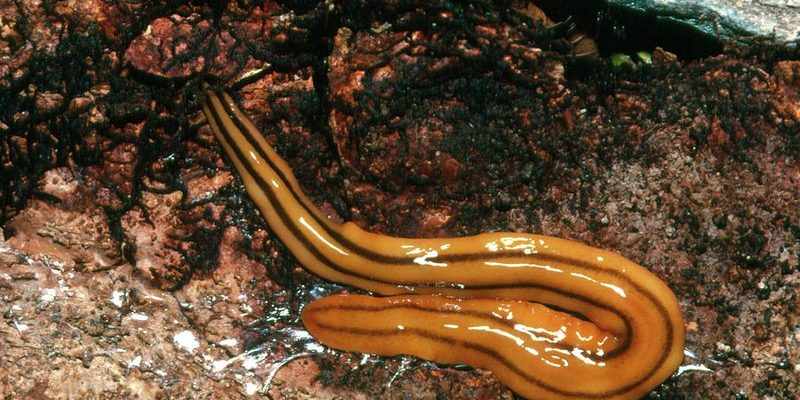
Planaria are often found in moist habitats like ponds and streams, where they glide through the water and on surfaces. Imagine a tiny ribbon swimming gracefully, feeling like a scene from a nature documentary. They belong to the phylum Platyhelminthes, which means “flatworms.” Planaria are known for their fascinating abilities, like regenerating lost body parts, which makes them a popular topic of study in biology.
What Do Planaria Look Like?
Planaria come in various shapes and sizes, though they usually sport a flat, elongated body. Picture a small, flat strip of jelly or a ribbon. Their bodies are typically between 1 to 3 centimeters long, and they can be found in different colors, like brown, white, or even greenish.
These little creatures have a distinct triangular head, which gives them a somewhat charming appearance. On their heads are light-sensitive organs called eyespots that help them sense light and dark. This adaptation is crucial for their survival, allowing them to navigate their watery environment effectively.
But the charm doesn’t stop there. Their bodies are covered in cilia—tiny hair-like structures—that help them swim and glide along surfaces. If you were to see one move, you’d marvel at how smoothly it transitions from one spot to another, almost like a dance in slow motion.
Where Do Planaria Live?
You might be wondering where you can find these fascinating creatures. Planaria thrive in freshwater habitats such as ponds, marshes, and slow-moving streams. They enjoy environments rich in organic matter, which provides ample food. Think about a serene pond surrounded by lush plants and a bit of debris at the bottom—that’s prime real estate for planaria!
In addition to their natural habitats, planaria can also be found in laboratory settings. Scientists often use them for research due to their unique regenerative abilities. Imagine researchers peering into a microscope, studying how these creatures can re-grow a lost tail or even an entire body! It’s a captivating intersection of nature and science.
The Amazing Regeneration Ability
One of the most remarkable features of planaria is their ability to regenerate. If a planarian loses a part of its body—say, its tail—it can re-grow it completely! This process is not just a minor repair; planaria can regenerate their entire body from a small fragment. Picture cutting a worm in half and, instead of dying, each half grows back into a full worm. Incredible, right?
This regeneration stems from specialized cells called neoblasts. These cells are like a repair crew, rushing to the injury site and turning into whatever cell type is needed to heal the injury. Researchers are fascinated by this process since understanding how it works can have implications for medicine, particularly in healing injuries and regenerating tissues in humans.
Additionally, this ability raises questions about the limits of regeneration. While some creatures can regrow limbs or tails, not all animals share this capability. So, why can planaria do it so efficiently? That’s a topic of ongoing research and debate in the scientific community.
How Do Planaria Reproduce?
Planaria have a unique way of reproducing that might surprise you. They can reproduce both sexually and asexually! In sexual reproduction, two planaria come together to exchange genetic material. They can be male or female, which is known as being hermaphroditic, allowing for flexible mating options.
On the other hand, they can also reproduce asexually through a process called fission. During fission, a planarian splits its body into two parts, and each part regenerates the missing sections. This means that one planarian can create two new planaria in the blink of an eye. This method of reproduction is efficient, especially in environments where food is plentiful and conditions are stable.
So, whether they’re teaming up for a little genetic exchange or simply splitting in two, planaria have found clever ways to ensure their survival and continuation as a species.
What Do Planaria Eat?
Planaria are primarily carnivorous, meaning they feast on small organisms like protozoa, tiny crustaceans, and even dead organic material. They hunt using a fascinating method. With a muscular pharynx that can extend out of their bodies, they suck in food like a tiny vacuum.
Imagine a planarian lurking in the shadows of a pond, patiently waiting for its meal to come close. Once it sees a suitable target, it extends its pharynx and swiftly devours it! They play a vital role in their ecosystem by helping to decompose organic matter and maintain the balance of their watery habitats.
Additionally, their diet helps them thrive in various environments. When food is abundant, you’ll find planaria flourishing, while a lack of food can lead to a decline in their populations. It’s a delicate balance that highlights the interconnectedness of life in water ecosystems.
Planaria in Scientific Research
Planaria have piqued the interest of scientists for years, particularly in the fields of regenerative medicine and biology. Their unique abilities offer insights into how regeneration works. Researchers study planaria to understand how tissue regeneration occurs, which may one day lead to breakthroughs in healing wounds or regrowing tissues in humans.
Moreover, planaria serve as model organisms in various experiments. For instance, they are used in studies of learning and memory. You might be surprised to learn that these simple flatworms can learn from experiences, such as avoiding certain stimuli. This capability draws parallels to more complex nervous systems and offers insights into the evolution of intelligence.
So, when you think about planaria, know that these small creatures are not just swimming around aimlessly; they’re helping unlock the mysteries of life itself!
Why Should We Care About Planaria?
You might be asking yourself, “Why should I care about these little worms?” Well, here’s the thing: planaria hold important keys to understanding biological processes, ecosystems, and even human health. By studying them, scientists can gain insights that impact medicine, conservation, and environmental science.
Moreover, planaria play a role in their ecosystems, contributing to nutrient cycling and the health of freshwater habitats. Healthy ecosystems are crucial for maintaining biodiversity, which directly affects our planet’s well-being.
In a broader sense, caring about creatures like planaria means caring about the intricate web of life that sustains us all. So the next time you think about fascinating organisms, remember that sometimes the most extraordinary things come in small, unassuming packages.
In conclusion, understanding planaria opens up a window into the complex and captivating world of biology. From their remarkable regenerative abilities to their role in research, they showcase the beauty and wonder of nature. So, next time you encounter a tiny flatworm, take a moment to appreciate the incredible life it represents!

